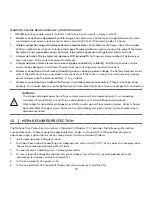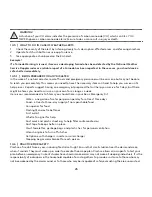
11 | ALARM LIMITATIONS
11.1 | LIMITATIONS OF SMOKE ALARMS
Smoke alarms play a key role in reducing deaths caused by home fires worldwide. However, smoke alarms can
only work if they are properly located, installed, and maintained, and if smoke reaches them.
WARNING: PLEASE READ CAREFULLY AND THOROUGHLY
1.
Smoke Alarms may not wake all individuals.
Create an escape plan and practice fire drills with all
members of the family at least twice a year. Make sure everyone is involved.
2.
Smoke Alarms cannot work without power.
Halo cannot work during long power outages once the backup
battery is dead. Halo will warn you when the rechargeable battery is low on power.
3.
Smoke Alarms cannot detect fires if the smoke does not reach the alarms.
This is why it’s suggested to
have a smoke alarm in each bedroom and in the hallways, as bedroom doors may be closed at night.
4.
Smoke Alarms may not sense smoke from another level of the home.
5.
Smoke Alarms may not be heard.
Though Halo comes with a loud alarm horn of 85 decibels, it may not be
heard if:
1) Residents are under the influence of alcohol or drugs,
2) Alarm is drowned by noise from stereo, TV, traffic, air conditioners or other appliances,
3) Residents are hearing impaired or sound sleepers. Special smoke alarms should be installed for those
who are hearing impaired. This smoke alarm is not intended to alert hearing impaired residents.
6.
Smoke Alarms have a limited life.
The unit should be replaced immediately if it is not operating properly.
You should always replace a Smoke Alarm after 10 years from the installation date. This manufacture date
will be located on back of the unit.
7.
Smoke Alarms cannot prevent or extinguish fires
. They are not a substitute for property or life insurance.
Note: There are situations in which a smoke alarm may not be effective to protect against fire as noted by
NFPA and UL 217. For example:
• Smoking in bed
• Leaving children unsupervised
• Cleaning with flammable liquids, such as gasoline
• Fires where the victim is intimate with a flaming initiated fire; for example: when a person’s clothes catch
fire while cooking
• Fires where the smoke is prevented from reaching the detector due to a closed door or other
obstructions
• Incendiary fires where the fire grows so rapidly that an occupant’s egress is blocked even with properly
located detectors
16















































